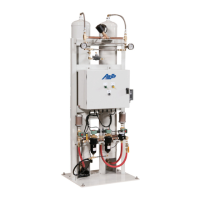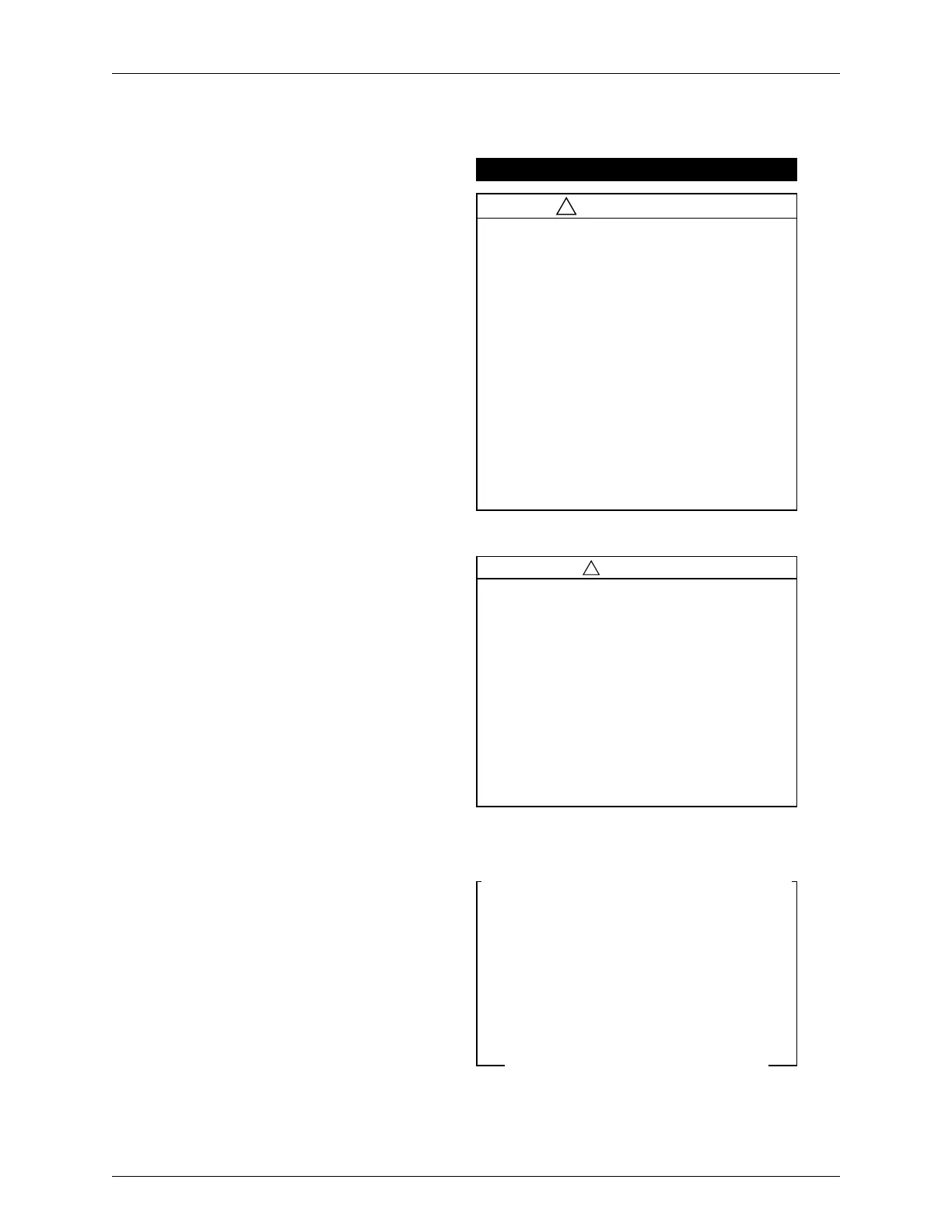118 AS-D+—AS-P Series Instruction Manual
AirSep Corporation
warranties are void in the event of misapplication and manufacturer
assumes no responsibility for any resulting loss. Maximum pressure rating
is 150 psig (10.3 bar) for plastic bowls, and 200 psig (14 bar) for metal
bowls. Temperature range is 32°F to 125°F (0°C to 52°C) for plastic
bowls, and 32°F to 150°F (0°C to 65.5°C) for metal bowls. [08/18/28
Series - 250 psig (17 bar) and 32°F to 150°F (0°C to 65.5°C)]
3. INSTALL as close as possible to point where air is being used.
4. REDUCING THE PIPE SIZE down to accommodate a smaller inlet/
outlet pipe size of a MICROalescer® filter does not affect proper
operation of filter. DO NOT select MICROalescer® filters by inlet and
outlet port sizes. MICROalescer® filters should be selected by the
airflow and inlet pressure required.
5. INSTALL a 5-micron prefilter ahead of the MICROalescer® filter to
prolong life of the element.
6.
INSTALL a pressure differential gauge (available from the manufacturer) to
determine when to change the disposable elements, or install an air
pressure gauge at inlet and another at outlet of MICROalescer® filter. When
the pressure differential reaches 7 psig (0.7 bar), change the element.
7. PURGE all traces of oil on the downstream side of coalescing filter prior
to installation.
8. DO NOT INSTALL MICROalescer® filter on an air line if there are any
chemicals in the compressed air that will attack the polyurethane foam
cover of the element.
9. WHEN INSTALLING filter element DO NOT touch the foam plastic
cover. Always handle it by the end plates. DO NOT touch the
MICROalescer® element once it has been placed in service. Pressure
on the outer foam cover can damage it once it is in service.
10. WHEN INSTALLING a chemical dryer, mount it after the
MICROalescer® filter.
11. WHEN INSTALLING a refrigerated air dryer, it may be installed before a
MICROalescer® filter. (See schematic elsewhere in these instructions.)
12. WHEN INSTALLING a Type D filter with an AC Pak element (Activated
Carbon for oil vapor adsorption), mount filter after air dryer.
13. DO NOT INSTALL a quick-opening valve if this causes a flow surge
beyond the flow rating of the unit.
WHEN TO CHANGE THE TYPE C ELEMENT
1. CHANGE ELEMENT when pressure differential reaches. Units with
differential pressure indicator will move to red at 7 psid.
2. DO NOT change element if oil stains appear on lower 1/5 of element.
This is normal; oil or water stains on the outer foam cover do not
indicate a need to change the element.
3. WHEN INSTALLING element using bottom retainer nut, tighten nut to 5-
6 ft. lbs.
4. DO NOT use oils or grease on element or bowl seals.
NOTE: Only excessive pressure drop requires the replacement of the
element. Excessive pressure drop indicates that the filter has been
removing solid contaminants as well as oil and water particulates.
TROUBLE-SHOOTING MICROALESCER® FILTER INSTALLATIONS
IF OIL AEROSOLS APPEAR DOWNSTREAM FROM
MICROALESCER® FILTER
1.
This could indicate lines were not properly purged of previous contaminants.
2. Check to see if sealing gasket/o-ring (depending on model) is in place
and making proper seal between the top of the element and the cover
casting. Make sure element is tightened firmly in place.
3. Make sure you are not flowing more air through the unit than its rated
capacity. Momentary high flows could cause oil bypass.
4. For maximum efficiency, air inlet temperature should be between 70°F
(21°C) and 90°F (32°C).
5. If inlet temperatures up to the maximum of 125°F (52°C) cannot be
avoided, install the Type C filter with a Type D element downstream. This
will catch the oil vapors that are usually responsible for oil downstream
at higher temperatures. Check that compressor is not drawing air at the
intake contaminated with harmful chemicals or hydrocarbons.
6. If the foam sock is torn or ruptured, oil may pass downstream from the
element. If this should occur, replace the element.
7. In compressors which have been running for a long time without
changing of oil, most oils will gradually change their chemical
compositions and may develop impurities which attack the plastic bowl,
filter seals, or outer foam sock. Periodic replacement of the compressor
oil will prevent this occurrence and extend compressor life.
FRENCH CANADIAN
Acetaldehyde
Solution de soude caustique (5%)
Tetrachlorure delethane
Acide propionique
Acide acetique (conc.)
Solution de potasse caustique (5%)
Chlorrrobenzene Pyridine
Acetone Acide formique (conc.) Chlorofome Sulfure de sodium
Acrylonitrile Chlorhydrine d’ethylene Cresol Styrene
Fluorure d’ammonium Dichlorure d’ethylene Cyclohexanol
Acide sulfurique (conc.)
Sulfure d’ammonium Gazoline (aromatique) Cyclohexanone Chlorure sulfureux
Acide benzique Acide chlorhydrique (conc.) Cyclohexene Gaz de tanin
Alcool benzoique Lait de chaux (CaOH) Dioxane Tetrahydronaphtalene
Bromobenzol Acide nitrique (conc.) Ether d’etyle Thiophene
Acide butyrique Laques a base de nitrocellulose Amine d’ethyle Toluene
Acide carbonique Hydroxychlorure de phospore Nitrobenzene Xylene
Disulfite de carbone Hilard Co.'s hil-phene Alcool methylique
Tetrachlorure de carbone
Chlorure de metylene Phenol * marque déposée
Dimethyle formamide Trichlorure de phosphore Freon* “Dupont”
MARQUES DÉPOSÉE DE QUELQUES HUILES POUR COMPRESSEURS, CAOUTCHOUCS
COMPOUND ET AUTRES PRODUITS QUI ATTAQUENT LES BOLS PLASTIQUES
Atlas “Perma-Guard” Houghton and Co. oil Petron PD287 Stauffer Chemical
Buna N* #1120, #1130 & #1055 Prestone FYRQUEL #150
Cellulube #510 Houtosafe 1000 Pydraul AC Tannergas
and #250 Kano Kroil Sears Regular Motor Oil Telar
Crylex #5 cement
Keystone penetrating oil #2
Sinclair oil “Lily White” Tenneco anderol
*Eastman 910 Marvel Mystery Oil
Some Loctite Compounds
#495 and #500 oils
Garlock #98403 Minn. Rubber 366Y Stillman #269-75 Titon
(polyurethane) National Compound #N11 (polyurethane) Zerex
Haskel #568-023 “Nylock” VC 3 Stillman #SR-513
Hilgard Co's hil phene Parco #1306 Neoprene (neoprene)
LISTE DES FLUIDES ATTAQUANT LE BOL EN MATIERE PLASTIQUE TRANSPARENTE (POLYCARBONATE)
NOUS NE POUVONS ENUMERER ICI TOUTES LES SUBSTANCES AGGRESSIVES.
VEUILLEZ NOUS CONSULTER POUR DE PLUS AMPLES INFORMATIONS.
AVERTISSEMENT
Afin d’éviter un fonctionnement imprévu du système pouvant
occasionner des blessures aux personnes et des dommages matériels:
• Débrancher l’alimentation électrique (si nécessaire) avant toute
installation, entretien ou conversion.
• Débrancher l’alimentation en air et dépressuriser toutes les
canalisations d’air connectées à cet appareil avant installation,
entretien ou conversion.
• Utiliser l’appareil conformément aux normes de pression,
température, et autres conditions spécifiées par le fabricant dans ces
instructions.
• Le médium doit être exempt d’humidité si la température descend en
dessous de 0°C.
• L’entretien doit se faire conformément aux procédures décrites ici.
• L’installation, l’entretien, et la conversion de ces appareils doivent
être effectués par des personnels qualifiés, au fait des techniques
pneumatiques.
• Après installation, entretien, ou conversion, les alimentations en air
et en électricité (si nécessaire) seront connectées et l’appareil testé
pour vérifier son fonctionnement correct et l’absence de fuites. Si
l’appareil présente une fuite audible ou ne fonctionne pas
correctement, ne pas l’utiliser.
• Les inscriptions concernant les avertissements et spécifications sur
l’appareil ne devront pas être recouvertes de peinture, etc. Si le
masquage est impossible, contactez votre représentant local pour
des étiquettes de remplacement.
!
!
ATTENTION
Les bols en polycarbonates, étant durs et transparents, sont idéaux pour
l’utilisation dans les filtres et lubrificateurs. Ils conviennent aux
environnements industriels normaux, mais ne devront pas être placés dans
des endroits où ils pourraient être soumis à une exposition à la lumière
directe du soleil, aux chocs, ou aux températures en-dehors de la plage
normale d’utilisation. Ce plastique est, comme tout autre, susceptible d’être
endommagé par l’action de certains produits chimiques. Les bols en
polycarbonate ne doivent pas être exposés aux hydrocarbures chlorés,
cétones, éthers, et certains alcools. Ils ne doivent pas être utilisés dans des
systèmes pneumatiques dont les compresseurs sont lubrifiés par des
fluides résistant au feu, tels que les esters et diesters de phosphate.
Les bols métalliques sont recommandés quand les conditions ambiantes et/
ou celles du médium sont incompatibles avec les bols en polycarbonates.
Les bols métalliques sont résistants à la plupart de ces solvants mais ne
doivent pas être utilisés en milieu fortement acide ou basique, ou dans une
atmosphère salée. Si de telles conditions existent, contactez le fabricant
pour des recommandations spécifiques.
NETTOYEZ LES BOLS EN POLYCARBONATE UNIQUEMENT A L’EAU
ET AU SAVON DOUX ! NE PAS utiliser d’agents nettoyants tels que
l’acétone, le benzène, le tétrachlorure de carbone, l’essence, le toluène,
etc., qui endommageraient ce plastique.
De plus, il est recommandé d’équiper les bols en polycarbonates de carters de
protection, là où une agression chimique est possible.

